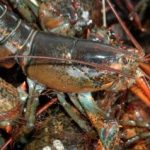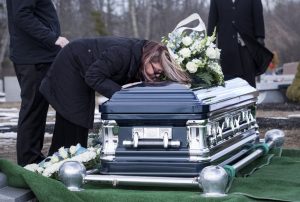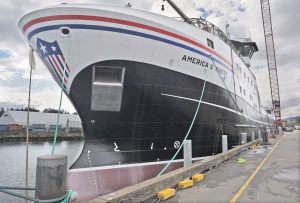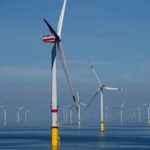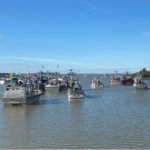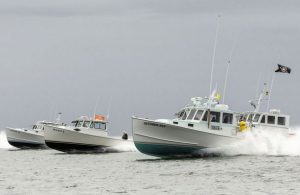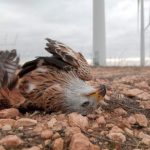Tag Archives: NIOSH

Safe Fishing Starts with Practice and Prep
The fishing season is currently underway for the North Pacific Fleet based out of Fishermen’s Terminal. From mid-June to September the fleet will fish the waters off the coast of Alaska for salmon, halibut, black cod, and other species. The fishers spent most of May and early June preparing their boats, provisioning, mending nets, and brushing up on safety best practices. The Seattle-based Fishermen’s Memorial organization aims to prevent accidental fisher deaths. Each year the organization honors local fishers who lost their lives at sea by adding their names to the Fishermen’s Memorial monument at Fishermen’s Terminal. Their ultimate goal is to stop adding names. Below are some of the safety demonstrations and exercises that were available to fishers at this year’s event. photos, >click to read< 07:54
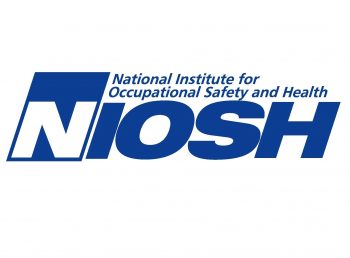
NIOSH Announces Availability of $6 Million in Commercial Fishing Safety Research and Training Grants
The National Institute for Occupational Safety and Health (NIOSH), in partnership with the U.S. Coast Guard (USCG), announced the availability of $6 million dollars in grant funding for commercial fishing safety research and training. The grants, which are supported and administered by NIOSH, will provide funding to qualified individuals in academia, members of non-profit organizations, municipalities, and businesses involved in the fishing and maritime industries. The funding will support research on improving the occupational safety of workers in the commercial fishing industry and critical training for this high-risk occupation. >click to read<10:52

Falling overboard is the second biggest killer of U.S. fishermen, second only to vessel sinkings.
From 2000 through 2016, 204 fishermen died after falling overboard. Nearly 60 percent were not witnessed and nearly 90 percent were never found. In every case, not one fisherman was wearing a life jacket. “I think there is a social stigma against it. It doesn’t look cool, it’s a sort of macho thing. I also think there is a lack of awareness of the fact that there are really comfortable, wearable PFDs.” Jerry Dzugan is director of the Alaska Marine Safety Education Association. >audio report, click to read<16:32
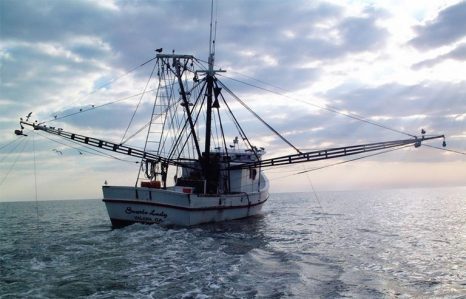
NIOSH regional reports highlight top dangers in commercial fishing industry
Vessel disasters and falls overboard are the primary hazards experienced by workers in commercial fishing – an industry with a fatality rate 29 times higher than the national average – according to a recent NIOSH analysis of four U.S. regions. NIOSH reviewed overall commercial fishing fatalities in Alaska, the Gulf of Mexico, and the East and West Coasts from 2010 to 2014. Researchers found that 184 fatalities occurred in the four regions: Alaska recorded 45, the West Coast had 30, the East Coast reported 60 and the Gulf of Mexico experienced 49. Vessel disasters (capsizes, fires, groundings, sinking) accounted for the most deaths with 80, followed by falls overboard with 53. Other categories included onboard, onshore and diving. click here to read the story 23:24

PFDs That Work – Personal Flotation Devices Prevent Fishermen Deaths
Researchers from the NIOSH Alaska Pacific Office asked commercial fishermen from 4 gear groups (crabbers, trawlers, longliners, gillnetters) to rate the comfort and acceptability of six modern personal flotation devices (PFDs). About 200 fishermen evaluated various PFDs for one month while working on deck so that wearable PFDs could be identified.1 Fishermen evaluated inflatable PFDs and foam PFDs that were either integrated into their rain gear or were worn in addition to raingear. Since deck work and fishing season varies for each gear group, fishermen had different preferences. Each gear group identified PFDs that are comfortable and easy to wear and are currently available for sale. The key to finding the proper PFD is to try on many to make sure they will work for the specific activities related to your type of fishing. Working on crowded decks and in close proximity to gear make it vitally important that a PFD not become a snagging hazard. Fishermen who work in colder weather may prefer a PFD with more foam padding for insulation against the weather. Read the rest here 14:53
How Bering Sea crab fishing was made safer
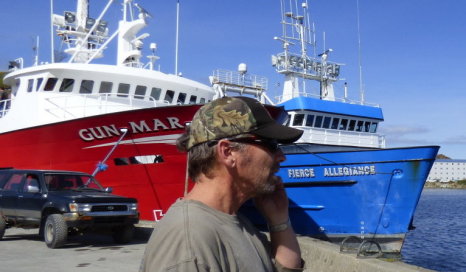 The dangers of the Bering Sea crab fishery have been made famous by the reality TV show “Deadliest Catch.” But in the last 15 years, that industry has become much safer, in large part thanks to collaboration between industry, scientists and regulators. Read the rest here 12:29
The dangers of the Bering Sea crab fishery have been made famous by the reality TV show “Deadliest Catch.” But in the last 15 years, that industry has become much safer, in large part thanks to collaboration between industry, scientists and regulators. Read the rest here 12:29
Distant Water Tuna Fleet – Higher risk of fatal injuries than in most other U.S. fishing fleets.
A NIOSH assessment of workplace hazards in the Distant Water Tuna Fleet found that workers in the fleet face a higher risk of fatal injuries than workers in most other U.S. fishing fleets. While falling overboard is the leading cause of death, NIOSH researchers also concluded that workers are at risk of head injuries, asphyxiation and amputations of fingers. In its report, NIOSH provides a number of recommendations, including: Read more here 13:01
NIOSH Takes On Injuries in the Fishing Fleet
 For more than 20 years, NIOSH has been working to prevent accidental deaths in the fishing industry. Now, these safety experts are tackling injuries — the kind fishermen are used to getting every season. As KUCB’s Lauren Rosenthal reports, that might make this a tougher problem to solve. Listen @kubc 16:49
For more than 20 years, NIOSH has been working to prevent accidental deaths in the fishing industry. Now, these safety experts are tackling injuries — the kind fishermen are used to getting every season. As KUCB’s Lauren Rosenthal reports, that might make this a tougher problem to solve. Listen @kubc 16:49
NIOSH Fishing safety program survives cuts – As long as the program lives, lifejackets are a major focus of that effort to try to save fishermen’s lives
 Falls overboard are the second largest cause of death in fishermen, Lincoln said. Only one of the 191 fishermen who died between 2000 and 2012 was wearing a lifejacket, Lincoln said. “A PFD doesn’t guarantee survival, but it certainly increases the chances of surviving a fall overboard,” Lincoln said. A recent NIOSH study looked into the preferred lifejackets for various commercial gear types by surveying fishermen and asking 200 to evaluate lifejackets for 30 days on deck. more@peninsulaclarion
Falls overboard are the second largest cause of death in fishermen, Lincoln said. Only one of the 191 fishermen who died between 2000 and 2012 was wearing a lifejacket, Lincoln said. “A PFD doesn’t guarantee survival, but it certainly increases the chances of surviving a fall overboard,” Lincoln said. A recent NIOSH study looked into the preferred lifejackets for various commercial gear types by surveying fishermen and asking 200 to evaluate lifejackets for 30 days on deck. more@peninsulaclarion
NIOSH’s commercial fishing safety arm was slated for the chopping block in a proposed fiscal year 2013 budget
 Ultimately, NIOSH must wait for a budget to pass to know what the funding level will be, said Public Affairs Officer Christy Spring. The Alaska Pacific Office is responsible for fishing vessel safety nationwide, despite its Alaska location. more@alasksjournalofcommerce
Ultimately, NIOSH must wait for a budget to pass to know what the funding level will be, said Public Affairs Officer Christy Spring. The Alaska Pacific Office is responsible for fishing vessel safety nationwide, despite its Alaska location. more@alasksjournalofcommerce






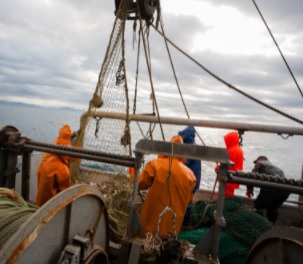
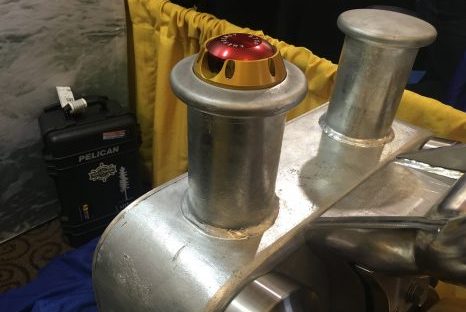
 Fishing is one of the most dangerous jobs in the United States. Last year the Bureau of Labor Statistics ranked fishing as the second most dangerous profession, behind logging, based on the number of fatalities. Between 2000 and 2012, there were 623 commercial fishing related deaths nationwide, according to a database run by the National Institute for Occupational Health and Safety. NIOSH has been studying the incidents that led to those deaths carefully, and believes hundreds of lives might be saved if more people would wear their PFD’s. Read
Fishing is one of the most dangerous jobs in the United States. Last year the Bureau of Labor Statistics ranked fishing as the second most dangerous profession, behind logging, based on the number of fatalities. Between 2000 and 2012, there were 623 commercial fishing related deaths nationwide, according to a database run by the National Institute for Occupational Health and Safety. NIOSH has been studying the incidents that led to those deaths carefully, and believes hundreds of lives might be saved if more people would wear their PFD’s. Read 


























